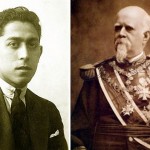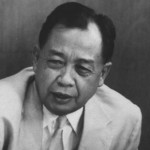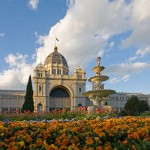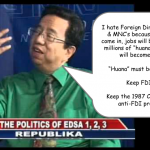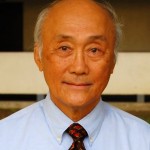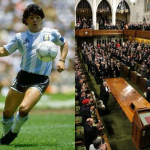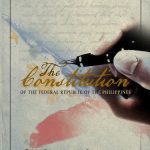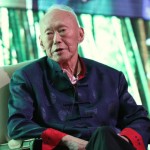
These days, when you think about Singapore, you imagine a photo of the “three buildings with a boat on top.” If you have friends who have been to Singapore, they prove that they visited it with a photo of them with Marina Bay Sands as the backdrop. For all intents and purposes, Singapore’s new de facto landmark is Marina Bay Sands.
But did you know that Marina Bay Sands is actually the result of Foreign Direct Investment?
Make no mistake, folks… Marina Bay Sands is majority-owned and operated by a foreign entity — an American company called “Las Vegas Sands Corporation.”
But Singaporeans and the Singapore Government have absolutely no issues with the fact that Singapore’s representative landmark is foreign-owned, because they are practical and business-minded and understand that Marina Bay Sands creates lots of jobs, other economic opportunities, and generates a lot of money that gets pumped into the Singapore economy, and a lot of tax revenues. Marina Bay Sands is a premier venue for international conventions, bringing in lots of attendees from all over the world to attend such events, and turning these attendees into tourists who pump a lot of money into the Singapore economy.
Overall, Singapore wins because of Marina Bay Sands because Singapore now has a nice landmark that tourists and visitors associate with the country, lots of jobs were created and Singapore earns a great deal of money from its operations. Singapore is more than happy to receive foreign direct investment for big projects such as this. In essence, Singapore did not need to spend money for this. Las Vegas Sands Corporation took the risk of spending all the money to make this impressive mega-structure.
Singaporeans don’t care that an American company owns Marina Bay Sands because Singapore benefits from it anyway!
This is a far cry from the barriotic-minded attitudes of many so-called “Nationalistic” Filipinos who make an oftentimes overreacting fuss about “national patrimony” when it comes to ownership by foreigners of corporations in the Philippines. Small-mindedness often takes over and prevails in the Philippines and the bigger picture never gets looked at. Instead of pragmatically looking at the fact that inviting in foreign direct investors and multinational corporations will create lots of jobs in such a short span of time for Filipinos based in the Philippines and that these MNCs will bring in technology, skills-training, and know-how that is quite often of a much higher level than what is available in the Philippines, these barriotic-minded “nationalists” (kuno) end up letting their irrationality and emotions take over and all they see is that “foreigners own the companies.” They don’t see the bigger picture in which employees and the wider society are benefiting from the employment generation and the skills and knowledge-transfer that occurs.
But let’s look at Singapore. Singapore’s prosperity is the direct result of Foreign Direct Investment. In fact its very existence as an entrepôt long before its independence in 1965 was the result of Foreign Direct Investment by the British East India Company. After Independence, the late founding Prime Minister of Singapore Lee Kuan Yew realized that the fastest way for Singapore to solve its unemployment problem and develop its economy was to bring in Foreign Direct Investors and Multinational Corporations.
As such, in Lee Kuan Yew’s book “From Third World to First”, he writes in pages 57-58:
“The accepted wisdom of development economists at the time was that MNC’s were exploiters of cheap land, labor, and raw materials. This “dependency school” of economists argued that MNC’s continued the colonial pattern of exploitation that left the developing countries selling raw materials to and buying consumer goods from the advanced countries.
MNC’s controlled technology and consumer preferences and formed alliances with their host governments to exploit the people and keep them down. Third World leaders believed this theory of neocolonialist exploitation, but Keng Swee and I were not impressed. We had a real-life problem to solve and could not afford to be conscribed by any theory or dogma.
Anyway, Singapore had no natural resources for MNC’s to exploit. All it had were hard-working people, good basic infrastructure, and a government that was determined to be honest and competent. Our duty was to create a livelihood for 2 million Singaporeans. If MNC’s could give our workers employment and teach them technical and engineering skills and management know-how, we should bring in the MNC’s.”
(Paragraph formatting edited for ease of reading)
In the preceding excerpt, the late Lee Kuan Yew reveals that he was exposed to the prevailing anti-MNC and anti-FDI mindset that dominated among many Third World economists and ideologues. This is the same mindset that was promoted by Filipino Leftist ideologues such as Joma Sison, Renato Constantino, Alejandro Lichauco, and are continuously peddled by leftist groups such as IBON Foundation, NEPA (National Economic Protectionism Association), and the MAN (Movement for the Advancement of Nationalism), Bayad Muna, and the CPP-NPA-NDF and its numerous front orgs.
But these ideologues cared more about ideology and theory, not much about practicality and real world problem-solving. Lee Kuan Yew, being an extremely sharp thinker felt that such theories may have sounded cute on paper and could stir people’s emotions, but would have likely failed or at best taken a very long time to succeed. He couldn’t afford failure. In fact, his practical-mindedness made him consider the fact that setting up industries required technology, know-how, and financial resources which the local investors & businessmen and even the country’s government did not have.
The lag-time in waiting for local industrialists to emerge from the current pool of businessmen would have meant that many unemployed Singaporeans would have been jobless and poor for a long time. Since Lee needed pre-packaged “ready-to-run” solutions, he felt that bringing in MNCs and Foreign Direct Investors who already had the financial resources, the know-how and the technology to hit the ground running was Singapore’s best chance to immediately create jobs in the shortest possible time.
It helps greatly that the late Lee Kuan Yew and his friend and colleague the late Goh Keng Swee were both highly analytical and highly intelligent skeptics who had doubts when pure theories and ideologies were bandied about without any practical basis. So the anti-FDI and anti-MNC sentiments prevalent among many third world economists did not impress them.
In page 66 of LKY’s book “From Third World to First”, Lee explains:
“We did not have a large group of ready-made entrepreneurs such as Hong Kong gained in the Chinese industrialists and bankers who came fleeing from Shanghai, Canton (Guangzhou), and other cities when the communists took over.
Had we waited for our traders to learn to be industrialists we would have starved…
It is absurd for critics to suggest in the 1990’s that had we grown our own entrepreneurs, we would have been less at the mercy of the rootless MNC’s. Even with the experienced talent Hong Kong received in Chinese refugees, its manufacturing technology level is not in the same class as that of the MNC’s in Singapore.”
(Paragraph formatting edited for ease of reading)
As it turns out, Lee Kuan Yew had practical experience as a businessman – particularly during the Japanese occupation. This experience made him understand the requirements of running business operations and understanding certain processes.
This is unfortunately what many Filipino leftist ideologues lack. Most of them have never operated businesses, and many have never worked in real industry. In most cases, they tend to be ivory-tower academics (usually from non-practical fields such as literature), as in the case of Joma Sison. Not understanding how business or industry works, such ideologues are quite likely to talk purely about highfallutin’ concepts such as “sovereignty” or “national patrimony”, but they do not understand the practical concepts of how a manufacturing or other industrial operation must be set up nor do they understand the kind of financial capital, technological know-how and skills-requirements needed to make it work successfully.
Attracting Foreign Direct Investment is the route that Singapore took in solving its unemployment problems because it is the fastest way to get companies set up as MNCs already have existing technology, know-how, and even monetary resources at their disposal. Even Malaysia under Mahathir bin Mohamad also tapped Foreign Direct Investments and MNCs in order to solve their unemployment issues.
From page 308 of Mahathir’s memoirs “A Doctor in the House”, Mahathir writes:
“Nevertheless the increase in foreign investments helped to create jobs and so lowered the unemployment rate, which was high at the time. Our approach differed from those of Japan and Korea, where the preference was for acquiring foreign technology for investment by the locals.
We did not have local entrepreneurs with the money or the willingness to invest in industries they were not familiar with. It was only after many years that the Malaysians acquired the knowledge and industrial skills to invest in manufacturing.
Thus it was through FDI that we succeeded in converting our agricultural economy into an industrial economy and eventually solving our unemployment problem.”
(Paragraph formatting edited for ease of reading)
Dr. Mahathir, just like his contemporary Lee Kuan Yew, had also been a businessman during the Japanese occupation, and had developed a keen understanding of how businesses are run. The quote below, taken from page 334 of “A Doctor in the House” reveals how Mahathir had a similar insight with Lee Kuan Yew regarding the fact that the local businessmen in Malaysia (and Singapore) were mostly traders and most did not have the confidence to go into certain new fields in which they were unfamiliar. It was for this reason that it was necessary to invite Foreign Direct Investors and MNCs that had the expertise and the financial resources to set up operations in industries or fields that local businessman had hitherto not had any expertise in.
Here is the quote from page 334, Mahathir writes:
“Managing a manufacturing industry is very difficult and there was no substantial industry in Malaysia at that time that we could take our lessons from.
We went for foreign investments because we did not have locals who were willing to take the leap. Locals wanted to stay within their comfort zones. When there is no competition in the mix, it is easy to get away with low quality, bad management, dirty processes and inefficiency.
But in a competitive environment, you must always be on guard. You have to look for ways to improve your product and be more cost-efficient. If you do not, you can be very sure that your competitors will be doing exactly that. Tax protection may provide some comfort but it should not make things too easy and discourage effort. It should certainly not cultivate bad attitudes and habits.”
(Paragraph formatting edited for ease of reading)
It is therefore foolish for Filipino leftist ideologues and proponents of “National Industrialization” to mindlessly and irresponsibly champion protectionist state-sponsored industrialization when local expertise in properly and successfully executing the operations required in such industrialization is woefully inadequate or non-existent.
The problem of the Filipino leftist ideologues is that they care more about their ideology and dogma than they do about the actual welfare of the ordinary Filipino People. They do not care that their plan for “National Industrialization” is likely to fail because they never cared to understand the prerequisites (financial capital, know-how, technology, etc) necessary to make it succeed, nor do they even care that attempting to make “national industrialization” actually happen can and will take a very long time before majority of Filipinos can be gainfully employed. Filipino leftist ideologues unfortunately aren’t really all that interested in job creation. Their primary goal is in fulfilling their ideological mandate.
In stark contrast, Dr. Mahathir, in page 372 of his memoirs, insists that job creation is of utmost importance:
“Creating jobs, especially by implementing policies that encourage the creation of private sector work opportunities, is the proper role of government.
That was why when Malaysia invited foreign investment, we did not insist on immediately collecting taxes. We were prepared to forgo taxes if the investors created jobs for our people.
In our view, no one who was prepared to work should remain unemployed. In fact, the Government was so successful in creating jobs that there are now more than two million foreign workers in the country. We cannot ourselves meet the demand for labour that our economic development has generated.”
(Paragraph formatting edited for ease of reading)
Singapore and Malaysia are both the two most developed economies of the ASEAN region and both countries relied heavily on Foreign Direct Investments and bringing in Multinational Corporations as a means of creating thousands of jobs in a short span of time and training many local employees to learn new technologies and skills that they would not have learned had the foreign investors not come in.
The single biggest indicator of Singapore’s reliance upon Foreign Direct Investments for job creation and economic development is the fact that Singapore’s new modern landmark is none other than a Foreign Direct Investment itself: Marina Bay Sands.
The Philippines ought to learn from this and realize that there is nothing wrong with relying upon FDIs and MNCs when it comes to fighting unemployment and developing the economy. It is precisely because so many Filipinos and so-called “intellectuals” have not yet learned this insight that the Philippines continues to have the highest unemployment rate in the ASEAN region and continues to have a chronic dependence on sending OFWs to foreign countries, Singapore included.
The Philippines must immediately remove all of its outdated and barriotic 60/40 restrictions and other anti-FDI restrictions that keep Foreign Direct Investments low.
CoRRECT™ the Constitution NOW!
(Singapore was not included in the graph above as its advanced First World status and extremely high FDI figures would dwarf all the other ASEAN countries as Singapore’s FDI in-flows are generally more than twice the highest FDI-inflows in the graph.)
* * *
About the Author
 Orion Pérez Dumdum is an IT Professional based in Singapore and is an accomplished and award-winning Stand-up Comedian during his free time outside of his IT day-job and his Constitutional Reform advocacy. Orion won First Prize in the 2014 Magners Singapore International Comedy Festival Best New Act Competition. He also won the August 2014 “Open for Steve-O Competition” that got him becoming the opening act for International Stunt-Comedian Steve-O from “Jack-Ass” in his Singapore tour.
Orion Pérez Dumdum is an IT Professional based in Singapore and is an accomplished and award-winning Stand-up Comedian during his free time outside of his IT day-job and his Constitutional Reform advocacy. Orion won First Prize in the 2014 Magners Singapore International Comedy Festival Best New Act Competition. He also won the August 2014 “Open for Steve-O Competition” that got him becoming the opening act for International Stunt-Comedian Steve-O from “Jack-Ass” in his Singapore tour.
Being an Overseas Filipino Worker himself, he has seen firsthand how the dearth of investment – both local and foreign – is the cause of the high unemployment and underemployment that exists in the Philippines as well as the low salaries earned by people who do have jobs. Being Cebuano (half-Cebuano, half-Tagalog), and having lived in Cebu, he is a staunch supporter of Federalism.
Having lived in progressive countries which use parliamentary systems, Orion has seen first hand the difference in the quality of discussions and debates of both systems, finding that while discussions in the Philippines are mostly filled with polemical sophistry often focused on trivial and petty concerns, discussions and debates in the Parliamentary-based countries he’s lived in have often focused on the most practical and most important points.
Orion first achieved fame as one of the most remembered and most impressive among the winners of the popular RPN-9 Quiz Show “Battle of the Brains”, and got a piece he wrote – “The Parable of the Mountain Bike” – featured in Bob Ong’s first bestselling compilation of essays “Bakit Baligtad Magbasa ng Libro ang mga Pilipino?” He is the principal co-founder of the CoRRECT™ Movement to spearhead the campaign to inform the Filipino Public about the urgent need for Constitutional Reform & Rectification for Economic Competitiveness & Transformation.


 I believe: This is a CoRRECT™ Video with a very positive message
I believe: This is a CoRRECT™ Video with a very positive message Walang Natira: Gloc-9's MTV Rap about the OFW Phenomenon
Walang Natira: Gloc-9's MTV Rap about the OFW Phenomenon

